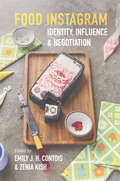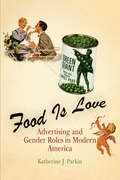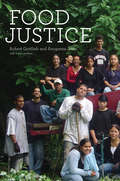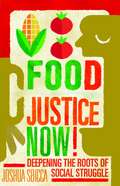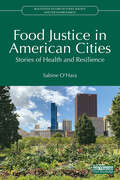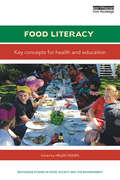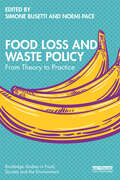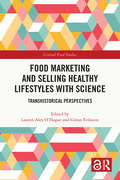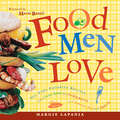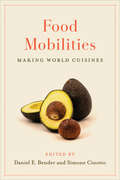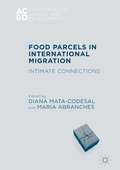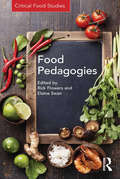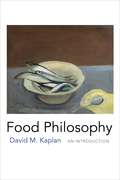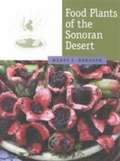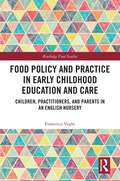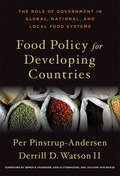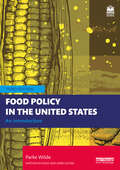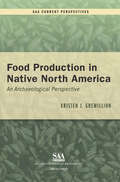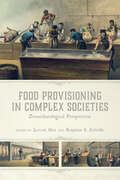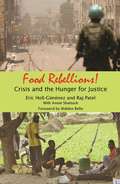- Table View
- List View
Food Instagram: Identity, Influence, and Negotiation
by Michael Z. Newman Rachel Phillips Yi-Chieh Jessica Lin Jonatan Leer Katherine Kirkwood Joceline Andersen Laurence Allard Emily Buddle Robin Caldwell Sarah Cramer Gaby David Sara Garcia Santamaria Deborah Harris Kc Hysmith Alex Ketchum Yue-Chiu Bonni Leung Tsugumi Okabe Tara Schuwerk Stinne Gunder Krogager Sarah E Tracy Emily Truman Dawn Woolley Zara WorthImage by image and hashtag by hashtag, Instagram has redefined the ways we relate to food. Emily J. H. Contois and Zenia Kish edit contributions that explore the massively popular social media platform as a space for self-identification, influence, transformation, and resistance. Artists and journalists join a wide range of scholars to look at food’s connection to Instagram from vantage points as diverse as Hong Kong’s camera-centric foodie culture, the platform’s long history with feminist eateries, and the photography of Australia’s livestock producers. What emerges is a portrait of an arena where people do more than build identities and influence. Users negotiate cultural, social, and economic practices in a place that, for all its democratic potential, reinforces entrenched dynamics of power. Interdisciplinary in approach and transnational in scope, Food Instagram offers general readers and experts alike new perspectives on an important social media space and its impact on a fundamental area of our lives. Contributors: Laurence Allard, Joceline Andersen, Emily Buddle, Robin Caldwell, Emily J. H. Contois, Sarah E. Cramer, Gaby David, Deborah A. Harris, KC Hysmith, Alex Ketchum, Katherine Kirkwood, Zenia Kish, Stinne Gunder Strøm Krogager, Jonathan Leer, Yue-Chiu Bonni Leung, Yi-Chieh Jessica Lin, Michael Z. Newman, Tsugumi Okabe, Rachel Phillips, Sarah Garcia Santamaria, Tara J. Schuwerk, Sarah E. Tracy, Emily Truman, Dawn Woolley, and Zara Worth
Food Is Love
by Katherine J. ParkinModern advertising has changed dramatically since the early twentieth century, but when it comes to food, Katherine Parkin writes, the message has remained consistent. Advertisers have historically promoted food in distinctly gendered terms, returning repeatedly to themes that associated shopping and cooking with women. Foremost among them was that, regardless of the actual work involved, women should serve food to demonstrate love for their families. In identifying shopping and cooking as an expression of love, ads helped to both establish and reinforce the belief that kitchen work was women's work, even as women's participation in the labor force dramatically increased. Alternately flattering her skills as a homemaker and preying on her insecurities, advertisers suggested that using their products would give a woman irresistible sexual allure, a happy marriage, and healthy children. Ads also promised that by buying and making the right foods, a woman could help her family achieve social status, maintain its racial or ethnic identity, and assimilate into the American mainstream.Advertisers clung tenaciously to this paradigm throughout great upheavals in the patterns of American work, diet, and gender roles. To discover why, Food Is Love draws on thousands of ads that appeared in the most popular magazines of the twentieth and early twenty-first centuries, including the Ladies' Home Journal, Good Housekeeping, Ebony, and the Saturday Evening Post. The book also cites the records of one of the nation's preeminent advertising firms, as well as the motivational research advertisers utilized to reach their customers.
Food Justice (Food, Health, and the Environment)
by Robert Gottlieb Anupama JoshiThe story of how the emerging food justice movement is seeking to transform the American food system from seed to table.In today's food system, farm workers face difficult and hazardous conditions, low-income neighborhoods lack supermarkets but abound in fast-food restaurants and liquor stores, food products emphasize convenience rather than wholesomeness, and the international reach of American fast-food franchises has been a major contributor to an epidemic of “globesity.” To combat these inequities and excesses, a movement for food justice has emerged in recent years seeking to transform the food system from seed to table. In Food Justice, Robert Gottlieb and Anupama Joshi tell the story of this emerging movement.A food justice framework ensures that the benefits and risks of how food is grown and processed, transported, distributed, and consumed are shared equitably. Gottlieb and Joshi recount the history of food injustices and describe current efforts to change the system, including community gardens and farmer training in Holyoke, Massachusetts, youth empowerment through the Rethinkers in New Orleans, farm-to-school programs across the country, and the Los Angeles school system's elimination of sugary soft drinks from its cafeterias. And they tell how food activism has succeeded at the highest level: advocates waged a grassroots campaign that convinced the Obama White House to plant a vegetable garden. The first comprehensive inquiry into this emerging movement, Food Justice addresses the increasing disconnect between food and culture that has resulted from our highly industrialized food system.
Food Justice Now!: Deepening the Roots of Social Struggle
by Joshua SbiccaA rallying cry to link the food justice movement to broader social justice debates The United States is a nation of foodies and food activists, many of them progressives, and yet their overwhelming concern for what they consume often hinders their engagement with social justice more broadly. Food Justice Now! charts a path from food activism to social justice activism that integrates the two. It calls on the food-focused to broaden and deepen their commitment to the struggle against structural inequalities both within and beyond the food system. In an engrossing, historically grounded, and ethnographically rich narrative, Joshua Sbicca argues that food justice is more than just a myopic focus on food, allowing scholars and activists alike to investigate the causes behind inequities and evaluate and implement political strategies to overcome them. Focusing on carceral, labor, and immigration crises, Sbicca tells the stories of three California-based food movement organizations, showing that when activists use food to confront neoliberal capitalism and institutional racism, they can creatively expand how to practice and achieve food justice.Sbicca sets his central argument in opposition to apolitical and individual solutions, discussing national food movement campaigns and the need for economically and racially just food policies—a matter of vital public concern with deep implications for building collective power across a diversity of interests.
Food Justice in American Cities: Stories of Health and Resilience (Routledge Studies in Food, Society and the Environment)
by Sabine O’HaraThis book documents food insecurity in urban communities across the United States and asks whether emerging urban food and agriculture initiatives can address the food security needs of American city dwellers. While America has sufficient food to feed its entire population, 38 million people are food insecure, with urban communities and communities of color having long borne the brunt of food inequalities. This book traces the evolving story of food by describing the people behind food system statistics, focusing on cities and suburban communities across America. In doing so, it raises questions not only about food security but about a food economy that can foster justice and sustainability and combat hunger and waste. By linking human faces to the data, the book reveals the many connections between food insecurity and unsustainable practices. The book concludes by discussing some of the pathways toward a more sustainable and just food system by linking the food system to the larger economy and the many sectors that are connected to food. Because of these multifaceted connections, food can be a unique catalyst for creating pathways toward a more just and sustainable economy that is more aligned with nature. This book will be of great interest to students and scholars of food justice, food security, urban food and agriculture, urban sustainability, and sustainable food systems more broadly.
Food Literacy: Key concepts for health and education (Routledge Studies in Food, Society and the Environment)
by Helen VidgenGlobally, the food system and the relationship of the individual to that system, continues to change and grow in complexity. Eating is an everyday event that is part of everyone’s lives. There are many commentaries on the nature of these changes to what, where and how we eat and their socio-cultural, environmental, educational, economic and health consequences. Among this discussion, the term "food literacy" has emerged to acknowledge the broad role food and eating play in our lives and the empowerment that comes from meeting food needs well. In this book, contributors from Australia, China, United Kingdom and North America provide a review of international research on food literacy and how this can be applied in schools, health care settings and public education and communication at the individual, group and population level. These varying perspectives will give the reader an introduction to this emerging concept. The book gathers current insights and provides a platform for discussion to further understanding and application in this field. It stimulates the reader to conceptualise what food literacy means to their practice and to critically review its potential contribution to a range of outcomes.
Food Loss and Waste Policy: From Theory to Practice (Routledge Studies in Food, Society and the Environment)
by Simone Busetti Noemi PaceThis book examines policy responses to food waste and loss, an issue of significant, global concern, with one-third of food produced for human consumption lost or wasted. Investigating food waste and loss under an interdisciplinary lens, the contributors employ a variety of methodological approaches, including quantitative and qualitative techniques, drawing on in-depth case studies and action research. The volume is organised into four parts: Understanding Food Loss and Waste, International Programmes, National Policies and Local Initiatives. The first part introduces the reader to the concept of food loss and waste, how it can be measured, its causes and consequences, and how it can be reduced. The second part is dedicated to international and cross-country case studies, with six chapters reviewing national policies implemented in France, Italy, Romania, Japan, China and the United States. In Part Four, three chapters are dedicated to local food recovery and redistribution initiatives. By focusing on different territories and different levels of governance, the book provides a detailed evaluation of food loss and waste policies, the barriers and opportunities of implementing the policies, as well as the impact they are actually having. The chapters are both descriptive and evaluative and draw out lessons for designing, implementing and reforming programmes. This book will be of great interest to students and scholars working on food waste, food policy, sustainable food systems, agricultural production and supply chains and public policy, as well as policymakers involved with developing and implementing programmes and policies to regulate and reduce food waste and loss.
Food Marketing and Selling Healthy Lifestyles with Science: Transhistorical Perspectives (Critical Food Studies)
by Lauren Alex O'Hagan Göran ErikssonThis book sets out to historicise our understanding of contemporary trends by studying the long relationship between science, food and drink marketing and the promotion of healthy lifestyles. It aims to bring together contemporary and historical research from a multimodal perspective, considering how scientific discourse and ideas about health and nutrition are channelled through visual and material culture.Using examples of advertisements, commercials and posters, the 16 chapters in this book will foster a cross-disciplinary and cross-temporal dialogue, uncovering links between past and present ways that manufacturers have capitalised upon scientific innovations to create new products or rebrand existing products and employed science to make claims about health and nutrition. They will, thus, demonstrate the continuity of science in food and drink marketing—even if fundamental ideas of nutrition have evolved over time. The book provides crucial new insights into the significance of the late nineteenth and early twentieth centuries as a period of innovation in food and drink marketing and showcasing how many of the marketing strategies employed today, in fact, have a far broader historical trajectory.It will be of great interest to students and scholars of Critical Food Studies, Media and Communication Studies, History of Science and Medicine and Cultural Studies, as well as nutritionists, dieticians, sportspeople, in addition to policymakers and practitioners working in the area of food and drink marketing.
Food Men Love: All-Time Favorite Recipes from Caesar Salad and Grilled Rib-Eye to Cinnamon Buns and Apple Pie
by Margie LapanjaOne of the best ways to enhance the quality of our lives is to treat ourselves to the foods we love-the more often, the better! Kitchen Goddess Margie Lapanja interviewed hundreds of men to compile this culinary collection of their favorite meals for a one-of-a-kind cookbook filled with recipes, fascinating food trivia, and fun stories from the kitchen. Whether a seasoned chef, a barbecue-happy bachelor, or a loving husband, men are taking up the tongs and giving the salad spinner a whirl in increasing numbers. Among the signature recipes of esteemed chefs and kitchen wizards, there are favorite feel-good feasts of superstars, sports heroes, luminaries, grill gurus, starving artists, burger kings, and every man in between. Included in Food Men Love is Tom Cruise's favorite Linguini dish, quarterback John Elway's Hamburger Soup, star chef Mario Batali's Bucatini all 'amatriciana, basketball legend Michael Jordan's 23 Peekytoe Crab Sandwich, and former Grateful Dead guitarist Bob Weir's Peanut Satay Sauce. Dishes are organized by course in chapters including: Warming Up His Appetite; Playing with Fire: Seeking Thrills with the G-r-r-rill; Fowl Play; and How Sweet It Is: Treat Him to His Just Desserts. Food Men Love provides the recipes for some all-time favorites that are sure to warm the heart of anyone.
Food Mobilities: Making World Cuisines (Culinaria #1)
by Simone Cinotto Daniel E. BenderBringing together multidisciplinary scholars from the growing discipline of food studies, Food Mobilities examines food provisioning and the food cultures of the world, historically and in contemporary times. The collection offers a range of fascinating case studies, including explorations of Italian food in colonial Ethiopia, traditional Cornish pasties in Mexico, migrant community gardeners in Toronto, and beer all around the world. In exploring the origins of the contemporary global food system and how we cook and eat today, Food Mobilities uncovers the local and global circulation of food, ingredients, cooks, commodities, labour, and knowledge.
Food Nations: Selling Taste in Consumer Societies (Hagley Perspectives on Business and Culture)
by Warren Belasco Philip ScrantonThis original collection abandons culinary nostalgia and the cataloguing of regional cuisines to examine the role of food and food marketing in constructing culture, consumer behavior, and national identity.
Food Parcels in International Migration: Intimate Connections (Anthropology, Change, and Development)
by Diana Mata-Codesal Maria AbranchesThis volume offers an ethnographic look at food sending and receiving practices among migrants in different regional contexts. For migrants and their families separated by migration, food circuits are a powerful and sensuous source of connection, which can help to maintain, reinforce and in some cases even create new transnational connections. The book takes food parcels as a material through with to think about relationships, consumption, exchange, and other fundamental anthropological concerns in changing societies, examining them in relation to wider transnational spaces. The book also contributes to a sensorial approach to social change by examining migrants and their families' experiences of global connectedness through familiar objects and narratives. By bringing in in-depth ethnographic insights from diverse social and economic contexts, the volumes widens our understanding of development experiences and moves beyond the divide between developing and developed countries; it contributors to our understanding of development by showing how global connections are experienced at a local level. Ethnographic chapters cover different geographic locations and migration routes (in Europe, Africa, America and Asia), as well as different types of migrants, including international students, asylum seekers, low-skilled labour migrants, irregular migrants or family migration.
Food Pedagogies (Critical Food Studies)
by Elaine Swan Rick FlowersIn recent years everyone from politicians to celebrity chefs has been proselytizing about how we should grow, buy, prepare, present, cook, taste, eat and dispose of food. In light of this, contributors to this book argue that food has become the target of intensified pedagogical activity across a range of domains, including schools, supermarkets, families, advertising and TV media. Illustrated with a range of empirical studies, this edited and interdisciplinary volume - the first book on food pedagogies - develops innovative and theoretical perspectives to problematize the practices of teaching and learning about food. While many different pedagogues - policy makers, churches, activists, health educators, schools, tourist agencies, chefs - think we do not know enough about food and what to do with it, the aims, effects and politics of these pedagogies has been much less studied. Drawing on a range of international studies, diverse contexts, genres and different methods, this book provides new sites of investigation and lines of inquiry. As a result of its broad ranging critical evaluation of ’food as classroom’ and ’food as teacher’, it provides theoretical resources for opening up the concept of pedagogy, and assessing the moralities and politics of teaching and learning about food in the classroom and beyond.
Food Philosophy: An Introduction (California Studies In Food And Culture Ser. #39)
by David M. KaplanFood is a challenging subject. There is little consensus about how and what we should produce and consume. It is not even clear what food is or whether people have similar experiences of it. On one hand, food is recognized as a basic need, if not a basic right. On the other hand, it is hard to generalize about it given the wide range of practices and cuisines, and the even wider range of tastes.This book is an introduction to the philosophical dimensions of food. David M. Kaplan examines the nature and meaning of food, how we experience it, the social role it plays, its moral and political dimensions, and how we judge it to be delicious or awful. He shows how the different branches of philosophy contribute to a broader understanding of food: what food is (metaphysics), how we experience food (epistemology), what taste in food is (aesthetics), how we should make and eat food (ethics), how governments should regulate food (political philosophy), and why food matters to us (existentialism). Kaplan embarks on a series of philosophical investigations, considering topics such as culinary identity and authenticity, tasting and food criticism, appetite and disgust, meat eating and techno-foods, and consumerism and conformity. He emphasizes how different narratives help us navigate the complex world of food and reminds us we all have responsibilities to ourselves, to others, and to animals. An original treatment of a timely subject, Food Philosophy is suitable for undergraduates while making a significant contribution to scholarly debates.
Food Plants of the Sonoran Desert
by Wendy C. HodgsonThe seemingly inhospitable Sonoran Desert has provided sustenance to indigenous peoples for centuries. Although it is to all appearances a land bereft of useful plants, fully one-fifth of the desert's flora are edible. This volume presents information on nearly 540 edible plants used by people of more than fifty traditional cultures of the Sonoran Desert and peripheral areas. Drawing on thirty years of research, Wendy Hodgson has synthesized the widely scattered literature and added her own experiences to create an exhaustive catalog of desert plants and their many and varied uses. Food Plants of the Sonoran Desert includes not only plants such as gourds and legumes but also unexpected food sources such as palms, lilies, and cattails, all of which provided nutrition to desert peoples. Each species entry lists recorded names and describes indigenous uses, which often include nonfood therapeutic and commodity applications. The agave, for example, is cited for its use as food and for alcoholic and nonalcoholic beverages, syrup, fiber, cordage, clothing, sandals, nets, blankets, lances, fire hearths, musical instruments, hedgerows, soap, and medicine, and for ceremonial purposes. The agave entry includes information on harvesting, roasting, and consumption-and on distinguishing between edible and inedible varieties. No other source provides such a vast amount of information on traditional plant uses for this region. Written to be easily accessible to general readers, the book is an invaluable compendium for anyone interested in the desert's hidden bounty.
Food Policy and Practice in Early Childhood Education and Care: Children, Practitioners, and Parents in an English Nursery (Routledge Food Studies)
by Francesca VaghiThis book is about food and feeding in early childhood education and care, offering an exploration of the intersection of children’s food, education, family intervention, and public health policies. The notion of ‘good’ food for children is often communicated as a matter of common sense by policymakers and public health authorities; yet the social, material, and practical aspects of feeding children are far from straightforward. Drawing on a detailed ethnographic study conducted in a London nursery and children’s centre, this book provides a close examination of the practices of childcare practitioners, children, and parents, asking how the universalism of policy and bureaucracy fits with the particularism of feeding and eating in the early years. Looking at the unintended consequences that emerged in the field, such as contradictory public health messaging and arbitrary policy interventions, the book reveals the harmful assumptions about disadvantaged groups that are perpetuated in policy discourse, and challenges the constructs of individual choice and responsibility as main determinants of health. Children’s food practices at the nursery are examined to explore the notion that, whilst for adults it is what children eat that often matters most, to children it is how they eat that is more important. This book contributes to a growing body of literature evidencing how children’s food is a contested domain, in which power relations are continuously negotiated. This raises questions not only on how children can be included in policy beyond a tokenistic involvement but also on what children’s well-being might mean beyond the biomedical sphere. The book will particularly appeal to students and scholars in food and health, food policy, childhood studies, and medical anthropology. Policymakers and non-governmental bodies working in the domains of children’s food and early years policies will also find this book of interest.
Food Policy for Developing Countries: The Role of Government in Global, National, and Local Food Systems
by Per Pinstrup-Andersen Derrill D. Watson IIDespite technological advances in agriculture, nearly a billion people around the world still suffer from hunger and poor nutrition while a billion are overweight or obese. This imbalance highlights the need not only to focus on food production but also to implement successful food policies. In this new textbook intended to be used with the three volumes of Case Studies in Food Policy for Developing Countries (also from Cornell), the 2001 World Food Prize laureate Per Pinstrup-Andersen and his colleague Derrill D. Watson II analyze international food policies and discuss how such policies can and must address the many complex challenges that lie ahead in view of continued poverty, globalization, climate change, food price volatility, natural resource degradation, demographic and dietary transitions, and increasing interests in local and organic food production.Food Policy for Developing Countries offers a "social entrepreneurship" approach to food policy analysis. Calling on a wide variety of disciplines including economics, nutrition, sociology, anthropology, environmental science, medicine, and geography, the authors show how all elements in the food system function together.
Food Policy in the United Kingdom: An Introduction (Earthscan Food and Agriculture)
by Rebecca Wells Martin Caraher Sinéad FureyThis book provides an introduction to food policy in the United Kingdom, examining policy development, implementation, influences and current issues. The book begins by providing a wide-ranging introduction to food policy in the UK, situating it within wider global debates and establishing key drivers, such as issues related to global citizenship, trade and finance. The use of food control as a policy lever is also discussed and contrasted with alternative approaches based on behaviour change. The book presents an overview of the history of UK food policy, from which there is much to be learned, before moving onto current challenges posed by political instability, both at home and abroad, global pandemics and cost of living crises. Foremost is the need to manage public health, including both malnutrition and obesity, while promoting sustainable and healthy diets, as well as the broader issues around addressing food security and food poverty. The book also examines public sector food initiatives, such as school food and early childhood provisions, and food regulation. As a part of food regulation, chapters examine food scares and food fraud, from chalk in flour to "horsegate". The role of media, marketing and advertising is also considered within a policy perspective. Taking a wider lens, the book also discusses the impact of global food trade and the financialisation of food on food policy in the UK and vice versa. The book is supported by instructor eResources on the Routledge website designed to support student learning as well as provide regular updates on UK food policy developments. The eResources include student activities, group exercises and links to further reading and additional resources. This book serves as a key introduction to UK food and agricultural policy for students, scholars, policymakers and professionals, as well as those interested in food systems, public health and social policy more widely.
Food Policy in the United States: An Introduction (Earthscan Food and Agriculture)
by Parke WildeThis third edition of Food Policy in the United States offers a timely update to the leading textbook dedicated to all aspects of food policy in the United States.This book begins with the economic interests of farmers and food producers and then moves on to examine nutrition policy, food justice, food security, and the environment. Finding motivation in real-world controversies and debates, chapters cover domestic agriculture, international agricultural trade, food and beverage manufacturing, food retail and restaurants, food safety, dietary guidance, food labeling, advertising, and federal food assistance programs for the poor. Building on the success of the second edition, which received the Distinguished Quality of Communication award from the Agricultural and Applied Economics Association (AAEA), this new edition has been revised and updated, offering greater attention both to food justice issues, and to economic methods. It covers policy changes since the 2018 Farm Bill, the publication of the 2020–2025 Dietary Guidelines for Americans, the 2021 update to the "Thrifty Food Plan", and President Donald Trump's approach to food and agricultural trade. The impact of COVID-19 and the continuing climate crisis are examined, alongside stalled child nutrition reauthorization legislation, reforms in food-labeling, and immigration policy. The online Instructor and Student Resources include supplemental economic appendices, problem sets, activities, and exercises: www.routledge.com/cw/Wilde. This book makes U.S. food policy more comprehensible to those inside and outside the agri-food sector whose interests and aspirations have been ignored.This book is essential reading for all students, researchers, and policymakers seeking to understand U.S. food policy from a wide range of interdisciplinary backgrounds, including food studies, agricultural and food economics and policy, public health and nutrition, and public policy.
Food Practices and Family Lives in Urban China
by Chen LiuThis book explores the emergent relationship between food and family in contemporary China through an empirical case study of Guangzhou, a typical city, to understand the texture of everyday life in the new consumerist society. The primary focus of this book is on the family dynamics of middle-income households in Guangzhou, where everyday food practices, including growing food, shopping, storing, cooking, feeding, and eating, play a pivotal role. The book aims to conduct a comprehensive and integrated analysis of themes such as material and emotional domestic cultures, family relationships, and social connections between the domestic and the public, based on a discussion of family food practices. These topics will not only offer academic readers a full understanding of the most innovative recent critical engagements with urban Chinese families but also provide more general readers with a broader view of food consumption patterns within the scope of domestic and family issues. This book will be of interest to sociologists, anthropologists, and human geographers as well as post graduate students who are interested in food studies and Chinese studies.
Food Preparation (3rd edition)
by R. T. Miller Robert G. HainesUpdated with 2005 USDA dietary guidelines and the new food pyramid, along with new materials on sanitation, computerized food service management systems, first aid and fire safety procedures, diet trends, and temperatures for cooking, cooling, and hot and cold storage, this comprehensive text emphasizes cost-effective and safe techniques along with advice on professional development. In 30 chapters Haines and Miller cover such topics as careers in food service, sanitation, tools and equipment, safety, nutrition, cooking methods and techniques, breakfast preparation, batter cooking, appetizers, seasonings, salads, cheeses, fruit, vegetables, pasta, soups, meat and fish, breads, cookies, pastries and specialty desserts. The also include hundreds of large-scale recipes (finally we know how to make six Key Lime pies at once), a glossary, and appendices on such topics as the mathematics related to food preparation. They have included a number photographs so well-done readers may be tempted to eat the pages.
Food Production And Rural Development In The Sahel: Lessons From Mali's Operation Riz-segou
by R. James BingenIn Mali and throughout the Sahel, governments increasingly rely on parastatal organizations to overcome the problems of lagging food production and rural poverty. This book examines the political and economic consequences of the efforts of one organization, Operation Riz-Segou in Mali, to increase smallholder food and cash crop production. Drawing extensively on fieldwork in Mali, the author finds that significant investments in irrigation facilities, financed by foreign aid, have not reduced the smallholder's vulnerability to the risks posed by weather and uncertain flood levels of the Niger River. The extension system discourages smallholder investment for long-term agricultural development because of its preoccupation with supervision and administrative control. Moreover, the Operation engages in many popular rural development activities—literacy programs, farmer training, women's artisanal centers—that give the facade of grassroots participation but in reality do not provide villagers a critically needed voice in local program administration. Comparing Operation Riz-Segou to similar parastatal agricultural development programs in the Sahel, Dr. Bingen discusses why only those policies deliberately designed and carefully implemented to share power with the majority of the people can lay the political and economic foundation required to overcome rural poverty and resolve the food crisis in the Sahel.
Food Production in Native North America: An Archaeological Perspective (SAA Current Perspectives)
by Kristen J. GremillionThis book in the SAA Press Current Perspectives Series provides a broad overview of the development of agriculture and other forms of resource management by the Native peoples of North America. Its geographical scope includes most of the continent’s temperate zone, but regions where agriculture took hold are emphasized. Temporally, this volume looks back as far as the first indigenous domesticates that emerged in the midcontinental region and follows the story into the era of European conquest.
Food Provisioning in Complex Societies: Zooarchaeological Perspectives
by Benjamin S. Arbuckle Levent AticiThrough creative combinations of ethnohistoric evidence, iconography, and contextual analysis of faunal remains, this work offers new insight into the mechanisms involved in food provisioning for complex societies. Contributors combine zooarchaeological and historical data from global case studies to analyze patterns in centralization and bureaucratic control, asymmetrical access and inequalities, and production-distribution-consumption dynamics of urban food provisioning and animal management. Taking a global perspective and including both prehistoric and historic case studies, the chapters in the volume reflect some of the current best practices in the zooarchaeology of complex societies. Embedding faunal evidence within a broader anthropological explanatory framework and integrating archaeological contexts, historic texts, iconography, and ethnohistorical sources, the book discerns myriad ways that animals are key contributors to, and cocreators of, complex societies in all periods and all places. Chapters cover the diverse sociopolitical and economic roles wild animals played in Bronze Age Turkey; the production and consumption of animal products in medieval Ireland; the importance of belief systems, politics, and cosmologies in Shang Dynasty animal provisioning in the Yellow River Valley; the significance of external trade routes in the kingdom of Aksum (modern Sudan); hunting and animal husbandry at El Zotz; animal economies from two Mississippian period sites; and more. Food Provisioning in Complex Societies provides an optimistic roadmap and heuristic tools to explore the diverse, resilient, and contingent processes involved in food provisioning. The book represents a novel and productive way forward for understanding the unique, yet predictably structured, provisioning systems that emerged in the context of complex societies in all parts of the world. It will be of interest to zooarchaeologists and archaeologists alike. Contributors: Joaquin Arroyo-Cabrales, Fiona Beglane, Roderick Campbell, Kathryn Grossman, Patricia Martinez-Lira, Jacqueline S. Meier, Sarah E. Newman, Terry O'Connor, Tanya M. Peres, Gypsy C. Price, Elizabeth J. Reitz, Kim Shelton, Marcus Winter, Helina S. Woldekiros
Food Rebellions
by Raj Patel Eric Holt-GimenezToday there are over a billion hungry people on the planet, more than ever before in history. While the global food crisis dropped out of the news in 2008, it returned in 2011 (and is threatening us again in 2012) and remains a painful reality for the world's poor and underserved. Why, in a time of record harvests, are a record number of people going hungry? And why are a handful of corporations making record profits? In Food Rebellions! Crisis and the Hunger for Justice, authors Eric Holt-Giménez and Raj Patel with Annie Shattuck offer us the real story behind the global food crisis and document the growing trend of grassroots solutions to hunger spreading around the world.Food Rebellions! contains up to date information about the current political and economic realities of our food systems. Anchored in political economy and an historical perspective, it is a valuable academic resource for understanding the root causes of hunger, growing inequality, the industrial agri-foods complex, and political unrest. Using a multidisciplinary approach, Holt-Giménez and Patel give a detailed historical analysis of the events that led to the global food crisis and document the grassroots initiatives of social movements working to forge food sovereignty around the world. These social movements and this inspiring book compel readers to confront the crucial question: Who is hungry, why, and what can we do about it?
